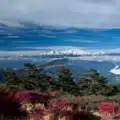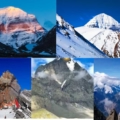As I make my way through the snow-dusted path of a small Himachal village, the crunch of fresh snow underfoot echoes through the crisp morning air. The faint, mystical sound of a temple gong reverberates in the distance as dawn breaks, creating a sense of tranquility that envelops the soul. While most of India celebrates Diwali with fireworks and bright lights, the Himalayas observe the festival in a serene and soulful manner. Here, Diwali is about more than lamps and sweets; it’s about inner reflection, spiritual connection, and harmony with the natural world. Picture standing by the Ganga in Rishikesh, watching diyas glide downriver under a starlit sky. Or waking in this same snow-dusted village, where each home glows softly in the crisp mountain air.
This unique celebration sets the scene for exploring how Diwali in the Himalayas weaves together spirituality and natural beauty at every turn.
The Spirit of Diwali in the Himalayas
While big-city fireworks make headlines, Diwali’s true spirit thrives in Himalayan valleys and remote towns, where celebrations are organic, rooted in devotion, nature, and community.
In Uttarakhand, Diwali is celebrated twice, creating a unique rhythm in the hills. After the traditional festival in October-November, the state observes Mukhya Diwali (or Budhi Diwali) weeks later, particularly in Garhwal and Kumaon. Rooted in the local lunar calendar and inspired by stories of Lord Ram’s return to Ayodhya, this celebration fills villages with glowing oil lamps, bonfires, and the music of folk dances drifting in the mountain air.
In Himachal Pradesh, Diwali unfolds with rustic charm. Temples and homes gently glow, neighbors offer sweets, and the bonds of the mountain community grow warmer. At the Raghunath Temple in Kullu or the Hadimba Devi Temple in Manali, devotion mingles with the gentle rhythm of daily village life.
To the east, in Sikkim, Arunachal Pradesh, and Ladakh, Diwali beautifully entwines with Buddhist traditions. Monasteries flicker with rows of butter lamps, while monks offer prayers for peace, prosperity, and enlightenment, casting a tranquil radiance over mountain passes. In a touching display of unity, communities share sweets and join hands in a joint lamp-lighting ceremony, symbolizing interfaith harmony and the blend of Buddhist and Hindu customs. This small, shared ritual gesture becomes a vivid testament to the intertwined cultural tapestry that defines these regions, showing that spiritual celebrations often cross paths, enriching the social fabric.
Top Himalayan Destinations to Experience Diwali Magic
1. Rishikesh & Haridwar, Uttarakhand
If you yearn for a Diwali steeped in devotion and spiritual energy, Rishikesh and Haridwar promise an unrivaled experience. On Diwali night, the Ganga Aarti at Parmarth Niketan and Har Ki Pauri transforms the river, with chanting priests, echoing bells, and hundreds of floating diyas setting the waters alight. Close your eyes and listen to the bells as they gently guide your thoughts inward, preparing you for the profound silence that follows. In this meditative pause, allow the busy world to fall away, so you can fully embrace the spiritual resonance that this sacred ritual offers.
Rishikesh offers yoga retreats and meditation centers with Diwali-themed sessions. Participate in candle-lit satsangs, sound healing, or peaceful riverside reflections, all unique to Diwali week, in this spiritual hub.
Travel Tip: For a unique stay, choose an ashram or riverside eco-lodge. To protect the environment, avoid fireworks and use eco-friendly diyas instead.
2. Manali & Kullu, Himachal Pradesh
During Diwali, Manali’s markets overflow with handcrafted candles, woollen shawls, and sweets. The Hadimba Temple glows warmly, and the crisp mountain air carries hints of pine and incense, blending scent and light in festive harmony. Amidst this vibrant setting, the unexpected sizzle of hot jalebi oil captures attention, while the distant, melodic notes of a shepherd’s flute drift through, adding a surprising touch of tranquility to the bustling atmosphere.
In nearby Kullu, Diwali unfolds with lively fairs, folk dances, and temple celebrations. Villagers gather in cheerful groups to sing Natti, exchange gifts, and light oil lamps throughout apple orchards, creating a scene rich with festive color and warmth.
Travel Tip: Book a homestay in a Himachali village for an authentic Diwali. If invited, join your hosts for a traditional meal of siddu, rajma, and sweet halwa.
3. Almora & Auli, Uttarakhand
For travelers seeking a quiet, soulful Diwali, Almora offers a serene celebration unique to this charming hill town. Perched on a ridge with views of the snow-clad Nanda Devi range, Almora glows with thousands of diyas. Every home decorates its verandah, and the town’s historic temples—like Kasar Devi and Nanda Devi Temple—come alive with local devotion and chanting.
Auli transforms Diwali into a snow-clad celebration. Quiet ski slopes, golden-lit peaks, and peaceful surroundings make this destination ideal for those seeking a crisp, serene festival experience.
Travel Tip: Visit Almora’s markets for handmade candles and brass diyas to take home. Stay until evening to enjoy panoramic twilight views of the Himalayan range.
4. Dharamshala & McLeodganj, Himachal Pradesh
Dharamshala and McLeodganj blend Diwali with Tibetan influences. Streets sparkle with prayer flags and butter lamps. Monasteries conduct peace prayers. Experience Diwali through meditation at Namgyal Monastery or take a stroll to enjoy Tibetan snacks and warmth.
Travel Tip: Head to Bhagsunag Temple in the evening, where locals light lamps and sing devotional songs near the waterfall. Join respectfully and observe local customs.
5. Tawang, Arunachal Pradesh
Tawang’s Diwali merges with Buddhist traditions. The illuminated Tawang Monastery stands out, with monks chanting and the valley glowing, making the Buddhist experience central to the local Diwali celebrations.
Although not traditionally a Hindu celebration, the energy of Diwali finds harmony here, symbolizing light conquering darkness —a message shared across faiths.
Travel Tip: When visiting monasteries, wear modest clothing. Take a moment to enjoy the panoramic sunset from the Tawang fort area for a truly memorable view.
6. Leh & Ladakh
Diwali in Ladakh is a tranquil experience—quiet, cosmic, and deeply reflective. The season arrives with crystal-clear skies and few travelers. Locals illuminate their homes and monasteries with lamps, while the starlit sky creates a tapestry of brilliance, offering solitude, spirituality, and a serene encounter with the mountains under countless stars.
Travel Tip: Pack warm clothes for the cold nights. Choose a local guesthouse to experience Ladakhi hospitality and try simple festival meals with your hosts.
Planning Your Himalayan Diwali Yatra
When to Go:
Late October to mid-November is ideal, depending on the lunar calendar. As the temperatures range from pleasant in the lower valleys to freezing in the higher altitudes, it’s wise to prepare in advance. Reserve buses or accommodations at least six weeks ahead for optimal travel dates, especially when temperatures drop below 5 °C. Consider packing warm layers such as thermal clothing, woolen socks, and insulated jackets to stay comfortable in varying climates.
What to Pack:
Pack warm clothes, woolen socks, eco-friendly diyas, a reusable water bottle, and traditional wear for temple visits.
Travel Tips:
- Select eco-conscious accommodations and avoid using fireworks to minimize your environmental impact. Disposing of waste properly not only helps protect the fragile mountain ecosystem but also enhances your travel experience by ensuring a lighter pack, making way for cherished local crafts. By embracing sustainable actions, you are not just fulfilling a responsibility, but gaining a richer, more authentic journey.
- Participate respectfully in local rituals: always remove your footwear before entering temples and monasteries, observe silence during prayers, and seek permission before taking photographs.
- Carry lightweight snacks like nuts and dried fruit, travel only with essentials, and check local weather before departures, as mountain routes can be unpredictable during early winter.
Getting There:
Indian Railways now offers convenient ways to explore the Himalayas during festive seasons through the IRCTC Round Trip Scheme. This scheme allows travelers to book return journeys in one go, with flexible dates and discounted fares, making it perfect for those planning multi-destination trips to places like Haridwar, Kathgodam, or Kalka for onward hill travel. Imagine sharing a warm cup of chai with fellow pilgrims just as dawn breaks, the train rhythmically winding through mist-laden valleys, making the journey itself an integral part of your Diwali adventure. It is an affordable and eco-friendly way to begin your Himalayan Diwali yatra, avoiding last-minute booking stress.
A Festival of Inner Light
In the Himalayas, Diwali transcends the rituals of lamps and sweets; it becomes a journey inward. The soft glow of diyas reflects in rivers, temples, and snowy peaks, reminding travelers that the true light of Diwali is the one that shines within.
When you celebrate Diwali in the Himalayas, you do not just witness the festival; you feel it. Each diya lit in the cold wind carries a message of hope and peace, echoing through the silent mountains.
As the valleys grow still and the stars take over the night sky, one truth stands out:
In the Himalayas, Diwali isn’t just seen — it’s experienced.






